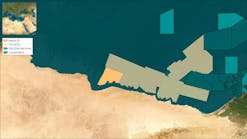Productivity the primary goal
Seismic software is more important than ever before. Data sets continue to expand in size, complexity, and density. Along with this expansion is the corresponding need to search, identify, quantify, and fully interpret both routine structural shapes and detailed seismic attributes. The software companies continually listen to their geoscientist users to identify ways to improve the usefulness of their software.The search for oil-bearing anomalies is at the heart of data set interpretation. They can come in many forms: structural traps, stratigraphic traps, diagenetic traps, or some combination trap. Finding those anomalies in a timely fashion is becoming more important. Oil prices are low, cash flows are constrained, companies are merging and reducing their staffs. More productivity is demanded from each professional. Software tools can help the professional geoscientist examine more data sets or more intently evaluated high-graded anomalies.
Once a possible trap is located in the seismic volume, additional information is needed to evaluate it: well logs, culture data (nearby platforms & pipelines), as well as historic production and engineering information from nearby fields.
Until recently, it has been difficult to get these data types into the "earth model" being built and examined by the exploration team. Many software improvements have been made to incorporate these different, but necessary data sets into the interpretation process in tightly linked software suites.
More and better ways are now available to view the data volumes. Software now allows not only simple paging of individual volume "slices," but full six-way attitude rotation of volumes and opacity control for individual segments.
This tool is very helpful for "seeing" through salt volumes. Once identified, the salt volume can be made transparent revealing the images underneath the canopy. Virtual reality displays are becoming more common and software is moving to provide this capability across all computer platforms. Display flexibility is a key to the evolving array of monitor types and projection systems.
Survey explanation
The 1998 Survey of 3D Seismic Modeling and Interpretation Software Systems lists the industry's top software companys and their software systems. This year's survey includes 17 companies and 53 software systems. Each company is listed with its corresponding software. The software's application is indicated by a *. The survey is broken into five major categories: 3D model building; 3D model validation; 3D visualization and interpretation, which includes data integration and interactivity; interpretation validation; and proximity to real-time. This year's survey also features the addition of a new column focusing on the use of virtual reality under 3D visualization and interpretation - interactivity.Copyright 1998 Oil & Gas Journal. All Rights Reserved.




